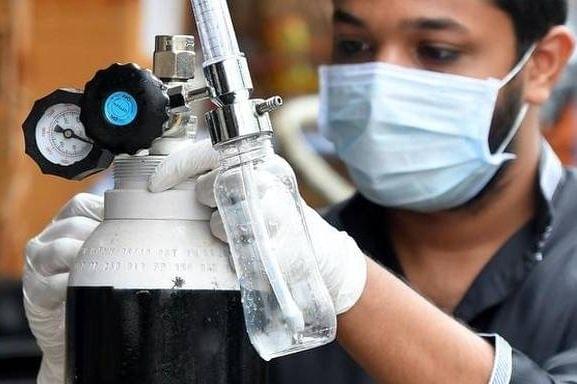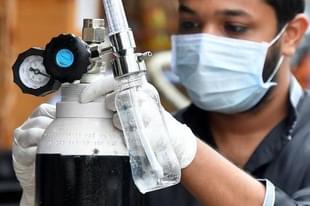News Brief
No Need To Panic, We Have Surplus Oxygen: Govt Tells SC; Bench Suggests Software For Real Time Updates On Allocation
Swarajya Staff
May 03, 2021, 12:39 PM | Updated 12:39 PM IST
Save & read from anywhere!
Bookmark stories for easy access on any device or the Swarajya app.


Amidst surging cases as part of the second wave of COVID-19 pandemic, the Supreme Court of India is questioning the Government of India over the measures to contain the pandemic, including critical supplies and vaccination.
The bench comprising Justices D Y Chandrachud, Nageswara Rao and S Ravindra Bhat has been hearing the suo moto case taken in relation to COVID-19 issues (In Re Distribution of Essential Supplies and Services during Pandemic), reports Live Law.
During the 30 April hearing, Justice Chandrachud said, “we are looking at playing a dialogical role through judicial review so that the thought process is initiated by policy makers.”
Here is a summary of different questions asked by the bench and answers given by the government regarding the oxygen supply for COVID-19 patients.
Oxygen Supply Crisis
Amidst the COVID-19 second wave, there have been frequent reports of patients dying from the lack of medical oxygen in different parts of the country. The national capital reported 407 COVID-19 fatalities and 20,394 cases with a positivity rate of 28.33 per cent yesterday (2 May).
According to data from hospitals being tracked by the government, 54.5 per cent patients admitted during the second wave required supplemental oxygen, a 13.4 percentage point increase from last year’s peak.
The bench questioned the Solicitor General over the oxygen crisis.
“Ground situation in Delhi is oxygen is not really available. Same in Gujarat, Maharashtra. Our hearing must make a difference. Tell us how much oxygen will be made available to critical states,” asked Justice Chandrachud.
In an order released late on Sunday, the bench directed the government to ensure that the deficit of oxygen to treat COVID-19 patients in the national capital should be rectified on or before midnight of 3 May.
The court asked the union government to act “in collaboration” with the States to “prepare a buffer stock of oxygen for emergency purposes and decentralise the location of the emergency stocks”.
“The emergency stocks shall be created within the next four days and are to be replenished on a day-to-day basis, in addition to the existing allocation of oxygen supply to the States,” the order read.
How Government Is Tackling It
The Solicitor General (SG) told the bench that the challenge Delhi faced was that it was a non-industrial state and oxygen had to be lifted from outside the state to fulfil demand, posing logistical challenges.
“Centre is doing all its best to extract oxygen from wherever possible; transportation and logistics is to be handled at the state level. Delhi may be finding difficulty to lift allotted quantity due to logistical problems, shortage of tankers etc. More and more tankers will ease problem,” he told the bench.
“Centre is providing more tankers. Some philanthropic industries are being involved to get tankers and oxygen on war footing. There is no oxygen shortage. But availability in some areas might be deficient because of inadequate lifting by states.”
When the bench said average demand of oxygen is 8,500 MT per day, the SG said that 10,000 MT of oxygen was available.
He added that there is a virtual control room working 24x7 to monitor oxygen needs of states.
Sunita Dawra, Secretary of Industries Dept. (who is also COVID positive), joined the virtual hearing and told the bench, “As a responsible officer, I will say, we have sufficient oxygen in the country. 51,000 MT is lying with us which is industrial oxygen out of which 19,871 MT is liquid medical oxygen. There is no need to panic. We have 13,000 MT of surplus oxygen in the country.”
“These are unprecedented times. Oxygen is being used at a very high rate. There is enhanced production of oxygen in the country from about 6,000 MT per day in August 2020 to 9,000 MT per day as on date.”
Dawra also informed the SC that steel plants were concentrated in the eastern region of the country while the demand of oxygen was higher in northern and western region.
“To meet the demand, a supply plan for oxygen has been planned wherein states are mapped to oxygen sources and quantity specified within a rolling plan. There is an empowered group to oversee allocation. It looks at how to allocate oxygen equitably,” she said.
Dawra also informed that the Central Virtual Control Room shares the allocation data to states on a real time basis. “For example, yesterday Goa was given 10 MT. Immediately Karnataka said they want as they are in distress. There is a streamflow of conversation. It is transparent. Information is shared with chief secretaries,” she said.
Dawra also informed the court that the government was continuously getting data from steel industries as to which state has lifted how much oxygen.
She also told the court how Uttar Pradesh has put GPS in tankers so that they can track the drivers and about the Oxygen Express trains transporting oxygen via rail.
Justice Chandrachud also asked the government if there can be a software to give real time updates about oxygen allocation.
"We have ISO containers too. They are are like capsules and very useful for logistical purposes. We received ISO containers from Singapore. We had a meeting of logistics committee and then states were allocated their share,” she told the court and showed the slide of allocation summary of oxygen for states as on 29 April.
Dawra said that every hospital can have a back up of medical oxygen cylinders.
“We had 4.35 lakh cylinders which is now close to 11.9 lakh cylinders. Global tender for import of oxygen has been floated for 50,000 tonnes of medical oxygen. Policy initiatives have been taken to permit conversion of cylinders of other gases to store oxygen, and also tankers of other gases to transport oxygen, and restrictions on use of oxygen for industrial use have been imposed,” Dawra said.
When Justice Ravindra Bhat asked her why out of 162 approved PSA plants only around 30 have started, Dawra said that the official from Health Ministry would be in a better position to answer.
The court further said that its suo moto hearing would not affect the proceedings in the high court over the same subject. However, it asked the High Court judges to exercise restraint in their comments.
Justice Chandrachud said, “..judges need also to exercise restraint. Because off-the-cuff remarks by judges can be damaging to persons. Though we have given High Courts liberty to proceed, judges need to show restraint to avoid off-the-cuff remarks.”
The SG also told the court that government had made it clear that hospitals cannot demand local address proof for admission. The bench requested the government to frame a policy on admission and address the issue of out-of-state patients being told to get supplies from their own state.





